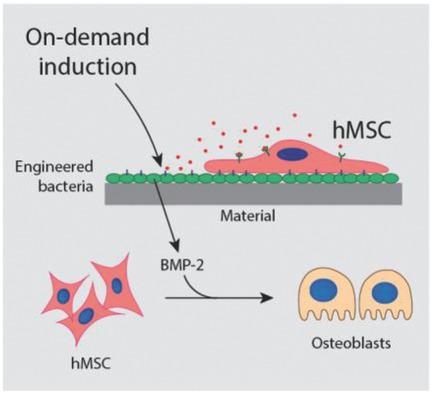当前位置:
X-MOL 学术
›
Adv. Mater.
›
论文详情
Our official English website, www.x-mol.net, welcomes your
feedback! (Note: you will need to create a separate account there.)
Bacteria‐Based Materials for Stem Cell Engineering
Advanced Materials ( IF 27.4 ) Pub Date : 2018-09-12 , DOI: 10.1002/adma.201804310 Jake J. Hay 1 , Aleixandre Rodrigo-Navarro 1 , Michaela Petaroudi 1 , Anton V. Bryksin 2 , Andrés J. García 3 , Thomas H. Barker 4 , Matthew J. Dalby 1 , Manuel Salmeron-Sanchez 1
Advanced Materials ( IF 27.4 ) Pub Date : 2018-09-12 , DOI: 10.1002/adma.201804310 Jake J. Hay 1 , Aleixandre Rodrigo-Navarro 1 , Michaela Petaroudi 1 , Anton V. Bryksin 2 , Andrés J. García 3 , Thomas H. Barker 4 , Matthew J. Dalby 1 , Manuel Salmeron-Sanchez 1
Affiliation

|
Materials can be engineered to deliver specific biological cues that control stem cell growth and differentiation. However, current materials are still limited for stem cell engineering as stem cells are regulated by a complex biological milieu that requires spatiotemporal control. Here a new approach of using materials that incorporate designed bacteria as units that can be engineered to control human mesenchymal stem cells (hMSCs), in a highly dynamic‐temporal manner, is presented. Engineered Lactococcus lactis spontaneously colonizes a variety of material surfaces (e.g., polymers, metals, and ceramics) and is able to maintain growth and induce differentiation of hMSCs in 2D/3D surfaces and hydrogels. Controlled, dynamic, expression of fibronectin fragments supports stem cell growth, whereas inducible‐temporal regulation of secreted bone morphogenetic protein‐2 drives osteogenesis in an on‐demand manner. This approach enables stem cell technologies using material systems that host symbiotic interactions between eukaryotic and prokaryotic cells.
中文翻译:

用于干细胞工程的细菌基材料
可以对材料进行工程设计,以提供控制干细胞生长和分化的特定生物学线索。但是,由于干细胞受到需要时空控制的复杂生物环境的调控,因此目前的材料仍局限在干细胞工程中。在这里,提出了一种新方法,该方法使用以设计的细菌为单位的材料,该材料可以被工程化以高度动态的时间方式控制人间充质干细胞(hMSCs)。工程乳酸乳球菌自发地定居在各种材料表面(例如聚合物,金属和陶瓷)上,并能够维持生长并诱导hMSC在2D / 3D表面和水凝胶中分化。纤连蛋白片段的受控动态表达可支持干细胞生长,而分泌型骨形成蛋白2的诱导时间调控则按需驱动成骨。这种方法使干细胞技术能够使用在真核细胞和原核细胞之间具有共生相互作用的物质系统。
更新日期:2018-09-12
中文翻译:

用于干细胞工程的细菌基材料
可以对材料进行工程设计,以提供控制干细胞生长和分化的特定生物学线索。但是,由于干细胞受到需要时空控制的复杂生物环境的调控,因此目前的材料仍局限在干细胞工程中。在这里,提出了一种新方法,该方法使用以设计的细菌为单位的材料,该材料可以被工程化以高度动态的时间方式控制人间充质干细胞(hMSCs)。工程乳酸乳球菌自发地定居在各种材料表面(例如聚合物,金属和陶瓷)上,并能够维持生长并诱导hMSC在2D / 3D表面和水凝胶中分化。纤连蛋白片段的受控动态表达可支持干细胞生长,而分泌型骨形成蛋白2的诱导时间调控则按需驱动成骨。这种方法使干细胞技术能够使用在真核细胞和原核细胞之间具有共生相互作用的物质系统。











































 京公网安备 11010802027423号
京公网安备 11010802027423号